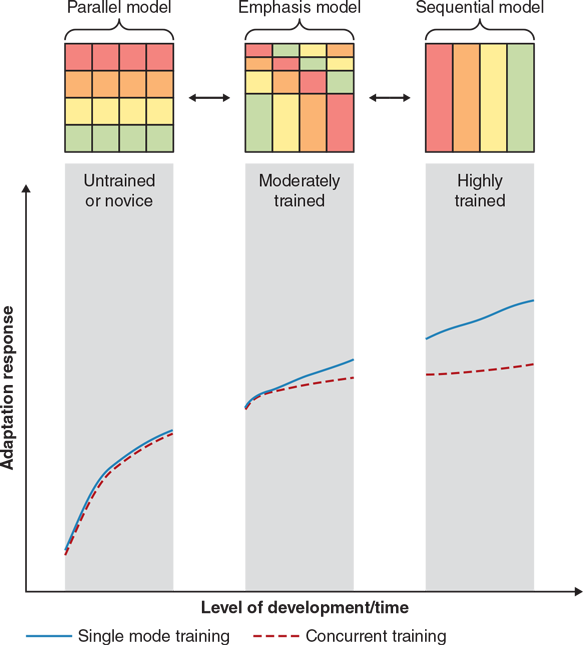Selecting appropriate periodization models
This is an excerpt from Scientific Foundations and Practical Applications of Periodization With HKPropel Access by G Gregory Haff.
When considering the selection of a periodization model, remember that parallel, emphasis, and sequential models are all useful. Numerous factors need to be considered when deciding which training model to employ, including the type of sport (i.e., individual versus team), the length of the competitive season, the density of the competitive schedule, the athlete’s training history, and the athlete’s level of development. Careful thought can help inform selection of a periodization model.
When considering long-term athlete development (LTAD), it is well-documented that multilateral training is a central part of the early stages of the athlete’s development (57, 90, 91). Due to the need to develop multiple training factors during this period, the parallel model of periodization would be a logical choice. As the athlete becomes more trained and progresses through the various stages of the LTAD pathway, they will move toward employing emphasis or sequential periodization models.
Support for progressing from multilateral (i.e., parallel) models toward unilateral (i.e., sequential) models can be found in the multilateral training literature (31). Coffey and Hawley (31) suggest that during the early phases of development, the skeletal muscles’ adaptive responses are similar between single mode (i.e., unilateral) and concurrent (i.e., multilateral) training. As the athlete develops, divergent exercise stimuli start to stimulate exercise-specific adaptations that initiate transformation of the skeletal muscle phenotype. This coincides with an increasing need for greater training loads to stimulate a disruption in homeostasis and further stimulate adaptive responses, which results in an increased occurrence of the interference effect. Specifically, as the athlete becomes more trained, there is a muted adaptive response and performance gain with concurrent training models when compared to models that employ a single mode of training (31). When contextualized with the periodization literature, there is a clear need to undertake greater training loads to continue to stimulate physiological adaptations and performance gains as one becomes more trained. As noted earlier in this chapter, using concentrated loading blocks (i.e., accentuated loading) and sequential models of periodization (55, 153) is recommended to increase adaptive responses as athletes become more trained because higher training loads can be employed.
When the parallel, emphasis, and sequential models of periodization (59) are aligned with the hypothetical time frame of skeletal muscle adaptation (31), the untrained or novice athlete would generally employ a parallel model of periodization (figure 5.21). As the athlete progresses to a moderately trained state, there will be a need for greater training loads, which can be addressed with the application of emphasis models of periodization (59). Once the athlete becomes highly trained, sequential models may be required to stimulate the physiological adaptations necessary to further increase performance capacity. Ultimately, the need to move away from parallel periodization models becomes increasingly important as the athlete’s training history lengthens.

Adapted from Coffey and Hawley (2017).
Another factor to consider when deciding which periodization model to use is the type of sport. Although it is often thought that parallel models are necessary for team sports, the increased density and length of the competitive schedule present in modern sports (3, 39) makes the management of training loads too difficult with this periodization model. Therefore, the emphasis model of period-
ization is recommended for modern team sport athletes who do not have long off-seasons and are required to participate in congested competitive schedules. The plasticity of the model allows for the training emphasis to shift based on travel distance, opponent strength, and the training period or phase alignment within the season (125, 126).
Emphasis models may be useful for individual sports that require the development of multiple training targets, such as combat sports. Success in a sport such as mixed martial arts requires a variety of technical skills (i.e., fighting styles) and a diverse array of physical performance capacities (79, 102). The emphasis model is a viable method for organizing the training for these athletes. The emphasis model is also useful for tactical athletes (e.g., military, fire, police) who must maintain a high state of readiness across a vast array of physical and performance capacities and for whom there is no competitive season. By organizing training with an emphasis model and cycling through the targeted emphasis every 2 to 4 weeks, tactical athletes are better able to maintain their state of preparedness and be physically ready for unforeseen engagements.
Although the three main periodization models are often thought of in isolation, there are situations in which multiple models could be used within an annual training plan. For example, early in the training year, after time away from training (i.e., transition phase), it may be warranted to use a parallel model to develop a balanced fitness base. After completing this period of training, key training attributes, such as maximal strength or power, could be developed with sequential models prior to the initiation of the competitive season. Once in the competitive season, an emphasis model could be employed in conjunction with a monitoring program that guides the progression of the emphasized training attributes.
More Excerpts From Scientific Foundations and Practical Applications of Periodization With HKPropel AccessSHOP

Get the latest insights with regular newsletters, plus periodic product information and special insider offers.
JOIN NOW
Latest Posts
- Women in sport and sport marketing
- Sport’s role in the climate crisis
- What international competencies do sport managers need?
- Using artificial intelligence in athletic training
- Using the evidence pyramid to assess athletic training research
- How can athletic trainers ask a clinically relevant question using PICO?


